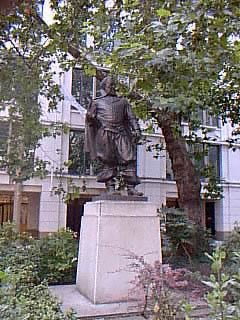|
|
 The American Connection
John Smith
The Hero of Virginia
1607 - 1638
 Captain John Smith was a swashbuckling adventurer in the finest tradition. Rising from humble beginnings as a cordwainer, Smith eventually went on to become Governor of Virginia and Admiral of New England. Captain John Smith was a swashbuckling adventurer in the finest tradition. Rising from humble beginnings as a cordwainer, Smith eventually went on to become Governor of Virginia and Admiral of New England.
A colourful and heroic figure, Smith won honours in the wars of Hungary in 1602 when he is said to have slain three Turks in single combat and cut off their heads. A grateful Duke of Transylvania awarded him a shield of arms featuring the heads as a result.
Smith was already famous for his escapades in foreign lands when he sailed for the New World from Blackwall in 1606 as part of an expedition sent to colonise the American coast. At that point the group of 144 men was lead by Captain Christopher Newport and it was he who claimed the site upon which they landed for England, naming it Jamestown, after King James I. When Newport returned home, Smith gained control of the new colony and he set about exploring the neighbouring countryside and trading with the natives. As legend has survived to tell, it was on one of these forays that Smith was captured by Powhatan, chief of the local native tribe. He afterwards claimed that he had been rescued from certain death by the chief's daughter, Pocahontas, and he wrote about the adventure in his Generall Historie of Virginia (1624). Whether Pocahontas was responsible for Smith's escape or not, she certainly married one of his group, John Rolfe, who later played a key role in developing the highly lucrative tobacco trade.
So prominent was Smith in Virginia's history that his fame earned him a mention two hundred years later in Thackeray's Virginians. He wrote : "I made acquaintance with brave Captain Smith as a boy, in my grandfather's library at home, where I remember how I would sit at the good man's knees, with my favourite volume on my own, spelling out the exploits of our Virginian hero. I loved to read of Smith's travels, sufferings, captivities, escapes, not only in America, but Europe."
John Smith returned to England around 1610. He died in 1631 and was buried at the church of St. Sepulchre's, Holborn, on the south side of the choir. Although the gravestone was damaged and later obscured under a new floor, the epitaph which was engraved on it has been reproduced on a brass memorial plate for the benefit of visitors. Praising Smith's many exploits, the rather saccharine eulogy begins: "Here lies one conquer'd that hath conquer'd kings!"
* A statue of John Smith (pictured above) stands outside the church of St. Mary le Bow
|
Copyright © Jan Collie 2002
Published by permission of the author.
All rights reserved. No reproduction, copy or transmission of this publication may be made without written permission.
| |
|